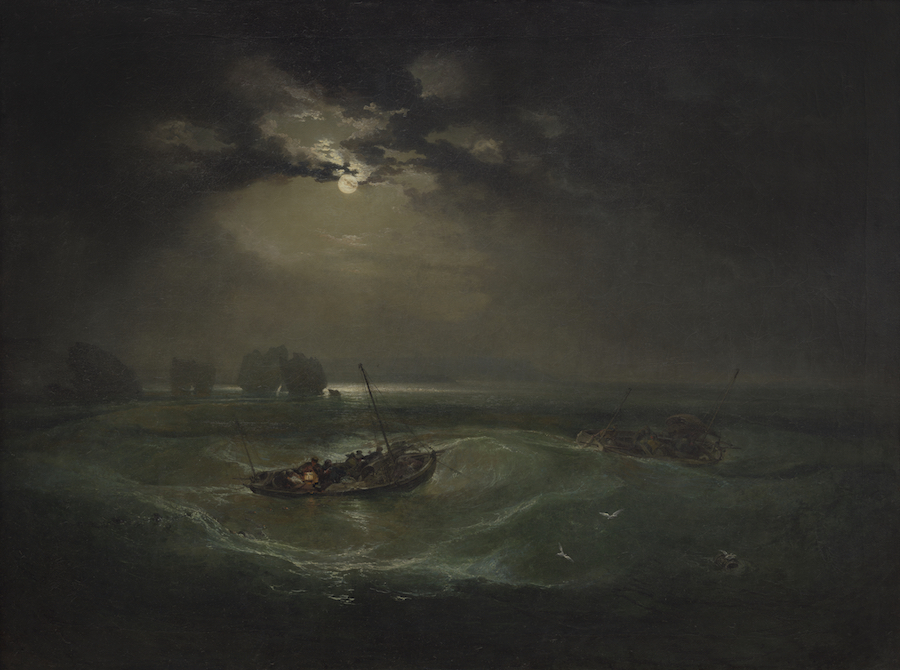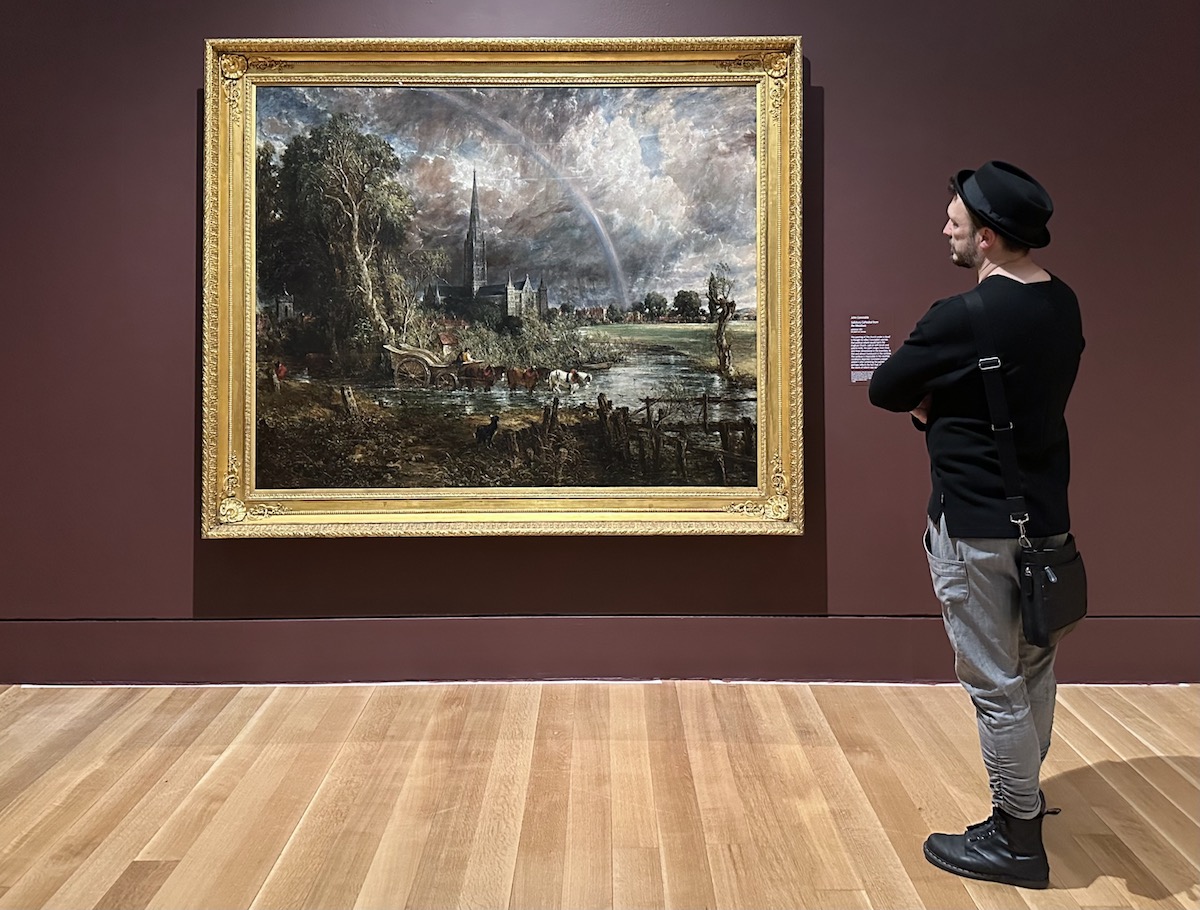To celebrate the 250th anniversaries of John Constable and J.M.W. Turner’s births, Tate Britain presents these two titans of the British landscape in their first major exhibition. And major it is: the range of watercolours, paintings and sketches is extensive, enabling a new assessment of these artists’ work in relation to one another.
With over 170 paintings and personal items, including Constable’s sketching chair, his paint-smeared palette, remarkable sketchbooks, Constable’s barge builders (1814), Turner’s wood and animal hair paint brushes, and a de rigeur miniscule leather-bound travelling watercolour case. These guys, who singularly transformed what landscape painting meant to the world, were definitely outdoorsy types. Turner the nomad, and Constable the earthbound Suffolk ruralist (as the caricatures go).
In France, in 1824, Constable’s The Hay Wain (1821), with its view of a cart in the River Stour, was celebrated by critics and artists at the Salon de Paris. Constable’s paintings so enamoured Delacroix that he visited his London studio later commenting, “Constable, admirable man, is one of the glories of England”. You can see why John Piper saw John Constable as a true source for French Impressionism. Constable’s city views, with the initial oil sketch for The Opening of Waterloo Bridge and larger versions, present the gritty industrial sublime of Georgian London with a remarkable brushwork virtuosity… Both artists engaged with a transforming landscape bearing new industrial scars.

In 1831, Constable’s Salisbury Cathedral from the Meadows (ca. 1829) hung between Turner’s Bridge and Vision of Medea, and his Caligula’s Palace with its golden, Claude Lorrain-like glow. The humans are like ants, and the force of nature abides in its entirety. Here, two Romantic visions of nature so radically different hung cheek by jowl next to each other. One critic commented that Constable had ‘none of the poetry of Nature like Mr Turner, but … more of her portraiture’.
J. M. W. Turner grew up in the hardscrabble Covent Garden, where he sold his first sketches in his father’s barber shop, and soon became an art star. He was elected to the Royal Academy early. Turner’s Self Portrait (1799), despite the tacky over-gilded frame and its freeform painterly scarf trailing off, is atypical for this young Academician and looks a bit too resolute. Fishermen at Sea (1796), Turner’s first ever work to be exhibited at the RA, likewise already has mastery of the medium. As Ruskin once commented, J. M. W. Turner understood the dynamic power of waves. His art is for the biosphere. As glaciologists bemoan the retreating icefields in the Swiss Alps, Turner’s The Passage of Mount St Gothard from the centre of Teufels Broch (Devil’s Bridge), 1804, is all Sturm und Drang. The cross-over in Turner’s paintings between a hidden inner world and chaotic outer atmospheres, some say, evidences childhood trauma (his mother went mad and off to Bedlam) and even neurodivergence. To his credit, Turner claims that energy for an ascendant aesthetic.

Turner’s loose Romantic watercolour sketches are impromptu renderings of nature as the ultimate force. A human-centred world with God as real estate manager may no longer seem a propos (with apologies to Sir Uvedale Price, whose Essay on the Picturesque, As Compared with the Sublime and The Beautiful (1794) detected these emerging symptoms!) The condition of the natural world is a sublime barometer of our global spiritual and cultural values. Does aesthetics now need redefinition, a rekindling of our bodily relation to the physical world and a cross-over exchange between art and science? There are hints of this in the comments of four artists, Bridget Riley, Frank Bowling, George Shaw and Emma Stibbon, in a video that acts as a contemporary endpiece of this exhibition. Is there a Planet B? No!
For my part, the Rivals and Originals show has completely transformed my view of the long-struggling Constable as a painter of rural Suffolk, to a true innovator. Constable stands out as the truly revolutionary painter of transcience, with all the parochial detail in each experiential bundle he captured – bit by bit. Turner could fall into a kind of mannerism, or method painting, for all his genius, but with an incomparable genius for the sublime, just as Shelley could with words.
His Mont Blanc poem, as such, reads, “The everlasting universe of things. Flows through the mind, and rolls its rapid waves…”, so with Turner. The “being there” experience, about the specifics of place, was the mantra and process. Caligula’s Palace and Bridge (1831), with its golden glow, is a universal thing. The humans are like ants, and the force of nature abides in its entirety. History is a temporary detail before the splendour of all the cosmic energy. After all, Turner’s last words were “The sun is God”.
For all the supposed rivalry, artists had to help each other, and in 1829, for instance, when John Constable was finally accepted into the Academy (after his wife, whom he loved dearly, had passed), Turner went to his place to congratulate him. With good intentions and no malice, the two were on friendly terms, both now Academicians.
Cosmic or parochial – take your pick – both artists embraced nature’s bounty, whether frenemies or rivals. Does it really matter at this point in time? They both reinvented landscape painting!
Turner & Constable: Rivals & Originals, 27 November 2025 – 12 April 2026, Tate Britain
Visit Here

